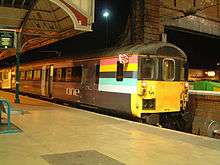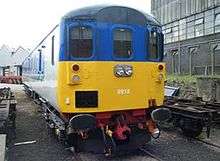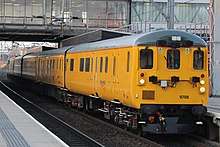Driving Brake Standard Open
A Driving Brake Standard Open (DBSO) is a type of railway carriage, converted to operate as a control car (not to be confused with DVTs as used in InterCity 225 sets). Fourteen such vehicles, numbered 9701 to 9714, were converted from Mark 2F Brake Standard Open (standard class coaches with brake van) carriages. Modifications included adding a driving cab and TDM equipment to allow a locomotive to be driven remotely. Using a system known as push–pull, the driver in the DBSO can drive the locomotive, even though it is at the rear of the train.
| British Rail DBSO | |
|---|---|
Anglia Railways DBSO 9701 at Colchester station in June 2003 | |
| In service | 1979–present |
| Manufacturer | |
| Family name | British Rail Mark 2 |
| Number built | 14 rebuilt |
| Number preserved | 2 |
| Number scrapped | 2 |
| Fleet numbers | 9701–9714 |
| Operator(s) | |
| Specifications | |
| Car length | 66 ft 0 in (20.12 m) |
| Width | 9 ft 3 in (2.82 m) |
| Height | 12 ft 9 1⁄2 in (3.899 m) |
| Maximum speed | 100 mph (160 km/h) |
| Weight | 33 long tons (33.5 t; 37.0 short tons) |
| Braking system(s) | Air |
| Track gauge | 1,435 mm (4 ft 8 1⁄2 in) |


Operations
The vehicles were converted in two batches. Numbers 9701–9710 were converted in 1979 for use on the newly introduced Glasgow–Edinburgh InterCity ScotRail push–pull service with specially modified Class 47/7 locomotives. A further four, 9711–9714, were converted in 1985/86. The fourteenth was a replacement for no. 9706, which was derailed and damaged beyond repair in the Polmont rail crash after it hit a cow.[1]
When first introduced, the DBSO fleet had half-cabs and retained their end gangways. They were later rebuilt to have full-width cabs, with the removal of the end gangways.[2]
In the late 1980s, with the introduction of Class 158 diesel multiple units on the Glasgow–Edinburgh corridor, the DBSO fleet was transferred en-masse, and converted to use the TDM system used by the AC electric locomotives used on the London Liverpool Street to Norwich services on the newly electrified Great Eastern Main Line. The Mark 2E/2F coaching stock used on the route was based at Crown Point TMD and rakes were marshalled into semi-permanent formations (numbered AR01–AR13). Traction was provided by Class 86/2 electric locomotives.[3]
As part of the privatisation of British Rail, the London–Norwich route became part of the Anglia Railways franchise. From 1997 onwards, a new livery of turquoise with a white stripe was introduced onto all Anglia stock. However, rake AR01, containing DBSO 9710 retained its old InterCity livery. On the Anglia services they were originally attached to the first class coaches but this was changed and they were attached to the standard class coaches as the seating in the DBSO was standard class.
In April 2004, the Anglia franchise became part of the new One franchise. The thirteen surviving DBSOs were still in service, although they were gradually replaced by Driving Van Trailers (cascaded from Virgin Trains). One DBSO, no. 9710, had the new one Anglia livery applied by means of adhesive vinyls, whilst retaining the InterCity livery underneath.
However, many of the new Mark 3 sets being received by Anglia were not originally accompanied by DVTs. For this reason a small number of DBSOs were retained until enough DVTs had been received. The last DBSOs were withdrawn from mainline service in December 2006. DBSO 9713 was preserved for further use on the Mid-Norfolk Railway, although this was later sold to Direct Rail Services and scrapped following component recovery.

In February 2007, Network Rail took delivery of five DBSOs, nos. 9701, 9702, 9703, 9708 and 9714. These have been converted to allow test-trains to run in push–pull mode, therefore eliminating the need to operate two locomotives (one at each end of the train).[4] Three of these (9701, 9708 and 9714) were subsequently fitted with a 60 kVA diesel generator to provide power for onboard systems while in operation.[5]
Ex Anglia MK2 driving trailer 9712 was sold to Northern Ireland Railways for use on the ex Gatwick set to convert it to push–pull operation using 111 class locomotives. It is registered as 8918 on NIR. The vehicle was delivered to Belfast on 26 June 2009, almost 14 months late on its contracted delivery date. The ex-Gatwick coaches were stopped on 19 June (before it was delivered) and have now been withdrawn.
In 2015, three were purchased by Direct Rail Services from British American Railway Services.[6] These were overhauled and in July 2015 entered service on Northern Rail Cumbrian Coast Line services.[7]
In September 2017, DBSO 9711 was acquired by Crewe Diesel Preservation Group for preservation alongside Class 47/7 locomotive 47712 and moved to Crewe Heritage Centre.
Fleet details
Full details of the DBSO fleet are given below:
| Key: | In Service | Stored | Preserved | Scrapped |
|---|
| Numbers | Built | Converted | Current Livery | Operator | Withdrawn | Status | |
|---|---|---|---|---|---|---|---|
| DBSO | BSO | ||||||
| 9701 | 9528 | 1974 Derby | 1979 Glasgow | NR Yellow | Network Rail | Operational | In service with Network Rail |
| 9702 | 9510 | 1974 Derby | 1979 Glasgow | NR Yellow | Network Rail | Operational | In service with Network Rail |
| 9703 | 9517 | 1974 Derby | 1979 Glasgow | NR Yellow | Network Rail | Operational | In service with Network Rail |
| 9704 | 9512 | 1974 Derby | 1979 Glasgow | DRS Compass | DRS | Stored | |
| 9705 | 9519 | 1974 Derby | 1979 Glasgow | DRS Compass | DRS | Stored | |
| 9706 | 9514 | 1974 Derby | 1979 Glasgow | 11/1984 | Scrapped following Polmont rail accident | ||
| 9707 | 9511 | 1974 Derby | 1979 Glasgow | DRS Compass | DRS | Stored | |
| 9708 | 9530 | 1974 Derby | 1979 Glasgow | NR Yellow | Network Rail | Operational | In service with Network Rail |
| 9709 | 9515 | 1974 Derby | 1979 Glasgow | DRS Compass | DRS | Stored | |
| 9710 | 9518 | 1974 Derby | 1979 Glasgow | DRS Compass | DRS | Stored | |
| 9711 | 9532 | 1974 Derby | 1985 Glasgow | Anglia Railways | Crewe Diesel Preservation Group | 12/2006 | Moved to Crewe Heritage Centre for restoration |
| 9712 | 9534 | 1974 Derby | 1985 Glasgow | Translink Gatwick | Downpatrick and County Down Railway | 04/2006 | Barrier vehicle at Downpatrick (now 8918) |
| 9713 | 9535 | 1974 Derby | 1985 Glasgow | 10/2016 | Scrapped at CF Booth, Rotherham. | ||
| 9714 | 9536 | 1974 Derby | 1986 Glasgow | NR Yellow | Network Rail | Operational | In service with Network Rail |
References
- Report on the Derailment that occurred on 30 July 1984 near Polmont
- DBSO Push–Pull
- Norwich to Liverpool St push–pull Archived 22 March 2012 at the Wayback Machine
- Image of Network Rail DBSO Archived 24 March 2012 at the Wayback Machine
- "Network Rail buys four DBSOs" Today's Railways UK issue 64 April 2007 page 70
- "Direct Rail Services purchase trio of Mk2 DBSOs" Rail issue 771 April 2015 page 31
- "Cumbrian top and tail 37s phased out" Rail issue 780 5 August 2015 page 22
External links
![]()